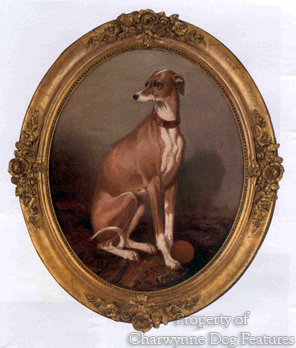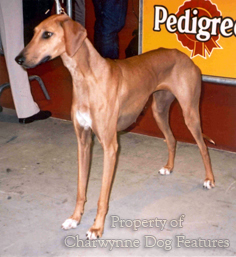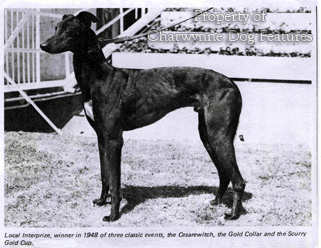738 ASSESSING THE AZAWAKH
ASSESSING THE AZAWAKH
by David Hancock
 This hunting and pastoral dog from the Azawakh (meaning land of the north) Valley, sometimes called the Tuareg Sloughi, has been described by one breed advocate as “fleetfooted enough to catch gazelles, hares and the European mouflon (wild sheep), courageous enough to ward off big predators, untiring like a camel and as beautiful as an Arab horse.” The Azawakh is not used on gazelle until it is fully mature, and was once carried across the saddle of their master’s horse until the game was sighted for a chase that could last more than an hour. Their nomadic breeders culled their canine stock ruthlessly, often retaining one male pup for hunting and a female for reproduction purposes. They were the treasured breed of the Oullimiden Tuareg, living in what is now Mali, Upper Volta, northern Nigeria and Mauritania.
This hunting and pastoral dog from the Azawakh (meaning land of the north) Valley, sometimes called the Tuareg Sloughi, has been described by one breed advocate as “fleetfooted enough to catch gazelles, hares and the European mouflon (wild sheep), courageous enough to ward off big predators, untiring like a camel and as beautiful as an Arab horse.” The Azawakh is not used on gazelle until it is fully mature, and was once carried across the saddle of their master’s horse until the game was sighted for a chase that could last more than an hour. Their nomadic breeders culled their canine stock ruthlessly, often retaining one male pup for hunting and a female for reproduction purposes. They were the treasured breed of the Oullimiden Tuareg, living in what is now Mali, Upper Volta, northern Nigeria and Mauritania.
A primitive breed, many of the bitches coming into season once rather than twice a year, the Azawakh has survived harsh conditions, living in the Sahel region of Mali, south of the Sahara, an area the size of France, amongst the once nomadic Tuareg and Berber people for a millennium or so. Alleged to lack the intense prey-drive of the Saluki, they have however the enhanced biddability of the herding breeds, acting as flock protectors for their pastoral owners. Although the breed can display variety of type, the gene pool is small yet apparently free of inheritable defects. Some historians believe that, before spreading south and west, the sighthounds of Eastern Arabia came from Asia originally, probably the steppes, real sighthound country. Studies on the blood of the Azawakh and the Sloughi showed that both have an additional allele on the glucose-phosphate-isomerase gene locus not found in other sighthounds and dogs but present in the coyote, fox and jackal. These two breeds however have distinct differences, both from one another and from their sister breed the Saluki. Azawakhs are claimed to be the most ‘feline’ of all dog breeds, aloof, independent, responding only to their masters – and not always to them!
I believe there are now well over 2,000 Azawakhs in Europe, mostly France and Germany, but they are not yet established here. At World Dog Shows they are soon identified by their lack of hindquarter angulation, unusual in a sighthound breed, and their featuring a distinctive range of coat colour. I am told that the Mali hunters often dye their hounds’ tails so that they can spot them in the hunt. The shoulder blades are quite prominent and the pin bones, the upper boney protuberance of the pelvis, often higher than the withers; the tuck-up is pronounced, the brisket deep but not always reaching to the elbows. Their gait is springy, almost flashy, with both the head and tail held high, giving an impression of suppleness and elasticity. Often strikingly coated, from sandy to rich red, sometimes with a black mask, usually with white markings, on the throat, chest, blaze, toes and tail-tip, they can come too in a highly distinctive red brindle.
In America, the leading breeder is David Moore, who favours the more primitive types he has imported from Africa to the more ‘showy’ ones preferred in France. He is anxious that when the breed is registered here, it should be bred to his type and the French standard overlooked. As the former colonial power in Mali, the French may win this one, but lurcher breeders would back David Moore in his declared preference for the hunting type ahead of the more extrovert exhibition hound. Breed characteristics should never become victim to show ring bias, as has happened in so many sporting breeds, and not to their advantage as sporting dogs. The French standard for example bans all-white dogs and discourages white patches on the body, both found in their country of origin. Moore’s hounds have these white markings, are considered ‘rustic’ and ‘less refined’ than those bred in Europe, yet are better natured and better hunting material. I know which type I would go for!
Sadly, I can visualize the exaggerators being attracted to this breed rather as they have to the Borzoi. The ears are very large and wide, the eyes almost feline, the sternum is very prominent and the tuck-up almost extreme. Cartoonists depicting ladies of leisure promenading with their elegant sighthounds in past decades would have a field day with this breed! They could in time become huge ‘Italian Greyhounds’, prized for their sheer elegance and daintiness, rather than their basic hunting dog phenotype. This would insult those Saharan hunters who have conserved these distinctive hounds for well over a thousand years, but it is unfortunately a well-worn path for a sporting breed of dog. It seems too, quite illogical to admire a primitive hunting dog and then disrespectively strive to alter its type and even its shape to suit a mainly urban fad. It is foolish too to attempt to claim an ancient origin or a supposed link to other more distant sighthound breeds merely on shared or similar physical features.
Mali was a medieval state controlling the trade routes between savannah and Sahara, reaching its peak in the 14th century, governed by France and independent in 1960, after a brief partnership with Senegal to the west. Around 5% of its people are Tuareg and Moor, both sub-groups of the Berber people. It shares a long northern border with Algeria, which is 25% Berber and a northern border with Mauritania, the homeland of the Moors. Mali’s location gave it significant trading importance, with Timbuktu known to every schoolboy. This means it was open to outside influences not cut off from them. The hunting dogs of Mali would soon become known from Morocco to the north-west and Egypt to the north-east. Similarly, valuable hunting dogs from both north and south were moved southwards along the ancient trade routes. It is unwise to think of the Azawakh developing in isolation and somehow retaining ancient purity of blood. The similarities between the Sloughi and the Azawakh are, not surprisingly, greater than the differences.
The high pin bones or haunch which have been claimed as a ‘unique’ feature of the breed are also present in the Cretan Hound, the Rampur Hound and other sighthound-type hunting dogs, which have no links to the Mali breed. Some Waterloo Cup winners of the late nineteenth century also featured the high rump and prominent pin bones seen in this breed. Modern show ring judges might claim that a dog higher at the haunch than the with ers could display a lack of coordination on the move and too straight a stifle. But they themselves so often reward exhibits that have excessive angulation in the hindquarters, with the dog’s hind-feet far far beyond the body, when standing. No Waterloo Cup winner ever carried such a terrible fault; it may be ‘showy’ but it can never be sound. If you study the anatomy of a highly successful racing Greyhound like Local Interprize, winner of three classic events in 1948, you soon spot the hind-feet immediately below the set of tail with no sign of hindquarter exaggeration. With well let-down hocks and great length of ribcage, this dog is a model for any sighthound exponent.
ers could display a lack of coordination on the move and too straight a stifle. But they themselves so often reward exhibits that have excessive angulation in the hindquarters, with the dog’s hind-feet far far beyond the body, when standing. No Waterloo Cup winner ever carried such a terrible fault; it may be ‘showy’ but it can never be sound. If you study the anatomy of a highly successful racing Greyhound like Local Interprize, winner of three classic events in 1948, you soon spot the hind-feet immediately below the set of tail with no sign of hindquarter exaggeration. With well let-down hocks and great length of ribcage, this dog is a model for any sighthound exponent.
I do hope this remarkable breed doesn’t become the latest show breed ‘must-have’, rather as the Borzoi, the Afghan Hound and the Saluki once were. They were never equipped for our climes, didn’t evolve for our expectations of a companion dog and are not built for our hunting country. They do provide however a sighthound gene-pool resource for those breeders wishing to improve their co-efficients of inbreeding, to reduce incidences of inheritable defects and to correct anatomical faults in overbred sighthound breeds. Some lurchermen might admire their independent nature but find their rather individual approach to performance in the field slightly bewildering!